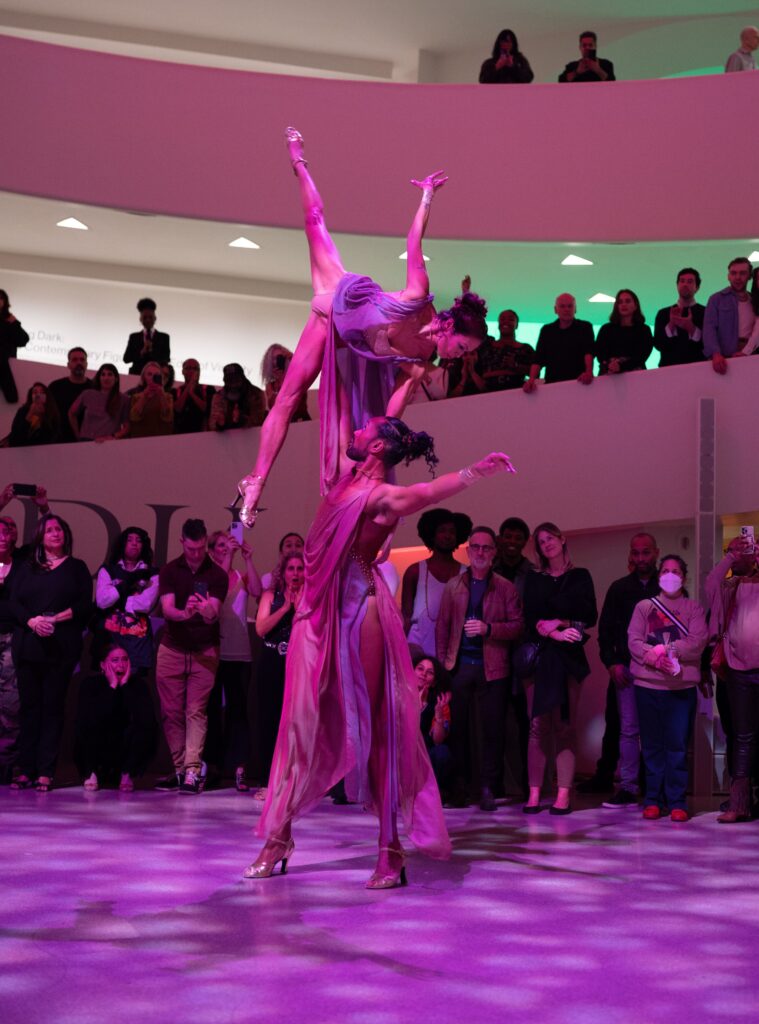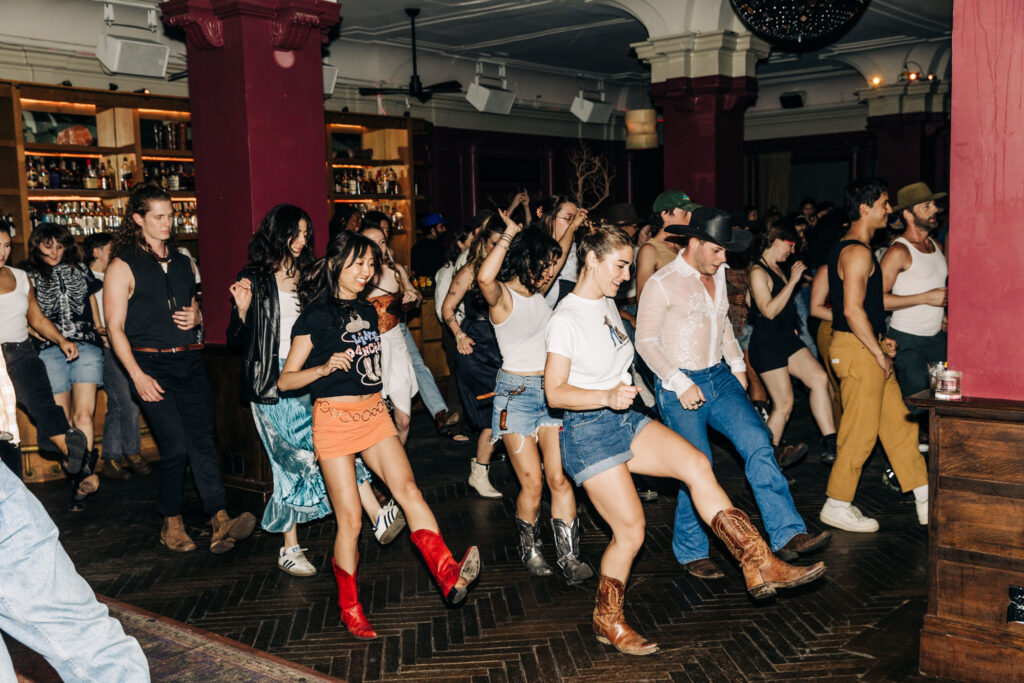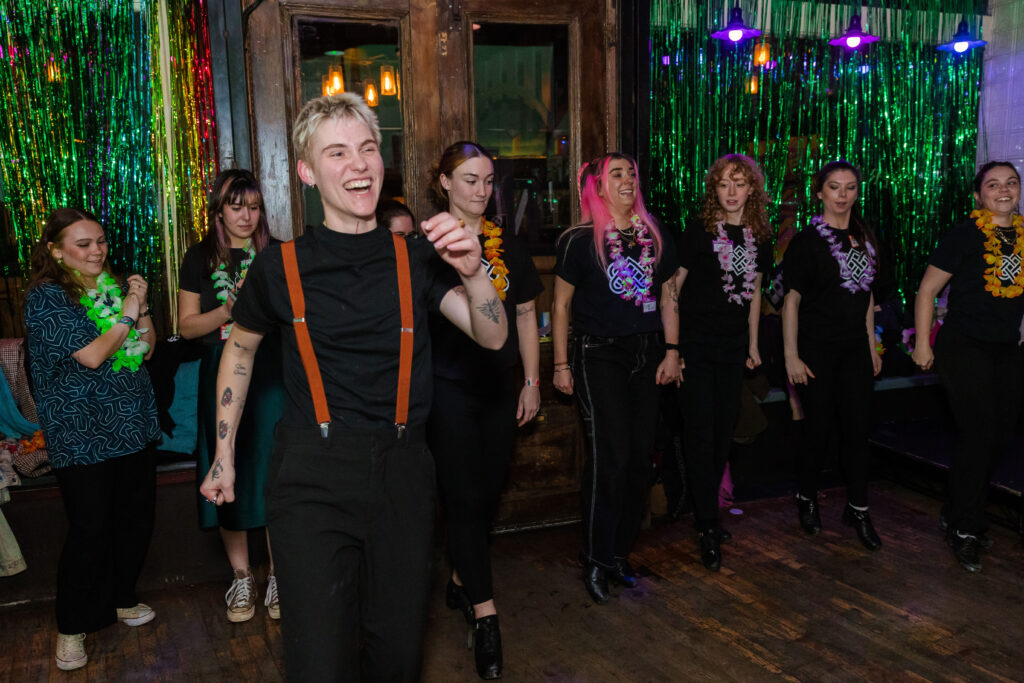On any given night time throughout the nation, queer individuals will be discovered dancing hand in hand, arm in arm, cheek to cheek in bars, bowling alleys, and conference facilities. From line dance courses to salsa events to Irish dance céilís, social dance tradition is turning into more and more queer-friendly, usually flipping the script on the strict gender binary these genres have historically upheld. And whereas the current surge in LGBTQ+ social dance is plain, so too are the progressive—and, in some instances, queer—roots of many of those dance kinds.
Hidden Histories
Conventional social dances have traditionally relied on a cisgendered male “chief” and feminine “follower.” However sure social dance genres have at all times accommodated gender-neutral partnering.
“Lindy Hop, for instance, has been a progressive dance kind for the reason that starting,” says dancer and choreographer Caleb Teicher. “It was began by younger Black individuals in Harlem, and was revolutionary for its time. Al Minns and Leon James had been two males who commonly carried out Lindy Hop collectively in films and on tv, and nobody questioned the appropriateness of them dancing with each other.” Hustle and line dancing had been additionally embraced by queer communities in New York Metropolis within the Nineteen Seventies and San Francisco within the Eighties.
However the queer histories of those dances have been largely eclipsed by heteronormative representations in popular culture. Abdiel Jacobsen, recognized professionally as Abdiel—a former principal dancer with the Martha Graham Dance Firm and a group organizer devoted to the cultural preservation of hustle—says the 1977 film Saturday Evening Fever marked a turning level in hustle’s historical past. “The film facilities round a white, straight, cisgendered man’s expertise in membership tradition and nightlife,” Abdiel says, “however what’s portrayed is the antithesis of the liberty and group that hustle is about.”

(Actually) Making the House
Immediately, dancers are dismantling the norms of historically gendered social dances. “In a whole lot of the bigger cities in America, it’s only a comparatively safer time to be out and proud, so persons are searching for out areas the place it feels secure to bounce with who they wish to dance with, or determine how they wish to determine,” Teicher says. “After all, there are a whole lot of locations and circumstances the place it’s not safer”—making the cultivation of LGBTQ+-friendly dance areas much more necessary.
Motivated by the need for these areas, queer individuals have begun dreaming up their very own social dance utopias. Stud Nation, which was “born from the legacy of queer dance areas and honors the wealthy historical past of LGBTQ cowboy tradition,” hosts weekly line dance classes and month-to-month events in Los Angeles, San Francisco, and New York Metropolis, and has exploded in recognition since its founding in 2021. “We wished to create a spot the place individuals can meet up, but it surely’s not preordained—there’s no visitor checklist,” says co-founder Sean Monaghan. “You simply present up and dance.”


Angelica Medina, who co-founded the Queer Afro Latin Dance Pageant in 2018 together with her spouse and dance associate Jahaira Fajardo, displays on how her personal upbringing knowledgeable the competition’s gender-neutral construction. “I didn’t develop up seeing two girls or two males dancing collectively, so I didn’t really feel like I had the permission to discover that,” she says. Along with gender-neutral partnering, the competition’s programming contains panels on consent, queer film screenings, and night socials for queer elders who may not wish to dance till midnight.
Even in social dance scenes that aren’t explicitly queer, some organizers have dedicated to creating environments the place everybody feels acknowledged. “In swing class pedagogy, some courses now observe the ELEF construction—all people leads, all people follows,” Teicher explains. “Within the context of gender-expansive ideology, the concept that these roles are malleable will be actually significant.”

A Fixed Evolution
Queer social dance is right here for the long term. “Folks have begun reclaiming this artwork kind, and not need to shrink themselves in an effort to take part,” says Fajardo. However a way of urgency permeates these areas, too.
“Queer tradition will be actually cynical and result in a lot bodily disgrace and isolation,” Monaghan says, “however associate dancing supplies this unbelievable platonic intimacy. With Stud Nation, I wish to create the world that I wish to develop into.”
Abdiel agrees, and stresses the vulnerability inherent in these genres. “You consent to being touched and moved all through an area, so there’s a whole lot of care and empathy that goes into it,” they are saying. “However there’s at all times room for extra empathy as we proceed approaching and evolving this apply.”
Generational Groundwork
When Alexandra Owensby, co-founder of Brooklyn Irish Dance Firm, initially dreamed up Gayli—a queer-friendly céilí (social dance gathering) at Mary’s Bar in Brooklyn, New York—she didn’t anticipate simply how therapeutic the occasion can be for LGBTQ+ individuals who studied Irish dance rising up. “We’ve obtained feedback about how Gayli lets them reclaim this factor they cherished as a child, however that finally grew to become very suffocating for them,” Owensby says. “To have the ability to present this house for individuals as their genuine, grownup selves has been a blessing.”

Fellow BIDC co-founder Erin O’Donnell has additionally been instructing Irish dance to youngsters in Brooklyn for 10 years, and credit them with serving to her transfer previous a number of the style’s conventional partnering phrases (“woman” and “gent”) and costuming expectations (skirts for the women and pants for the boys). “Youngsters like to repeatedly ask ‘However why?’ and while you’re requested that query sufficient instances, you’re lastly like, ‘Possibly it doesn’t should be a rule anymore,’ ” she says.
O’Donnell’s experiences as a instructor have imbued her with a brand new sense of duty. “We’re elevating the following era of dancers, a few of whom come out at a younger age,” she says. “We have to be sure that the studio is a secure house for them, for the reason that broader dance group may not be as accepting.”
Although Janaye Pohl doesn’t have a conventional dance background, they’d carried out choreographed routines with their highschool’s marching band and drumline. They discovered a particular form of affirmation and acceptance, and a reignited ardour for efficiency, at Stud Nation, which they attended for the primary time in Might 2023. Pohl has turn out to be a fixture on the occasion’s San Francisco get together, demonstrating dances onstage.
“As a nonbinary queer individual, I really feel a whole lot of aid round not having to adapt to a job primarily based on how others understand me,” Pohl says. “The ritual of asking the query ‘Lead or observe?’ is empowering, and I can’t think about dancing in an area the place it’s assumed I’ll take a sure position primarily based on gender.”
Pohl additionally acknowledges how queer social dance areas will help construct lasting group—and acknowledges the queer country-and-western dance pioneers who laid the groundwork for in the present day’s scene. “In San Francisco, we’re fortunate to have nice examples of established communities just like the Sundance Saloon, which has been round for 26 years, or Starlight Strut, which is particularly for girls, trans, and nonbinary queer people,” they are saying. “I really feel optimistic that these kinds of social dance areas are literally creating extra of what people are searching for, which is real-life connection and group versus only a place to drink or get together.”

